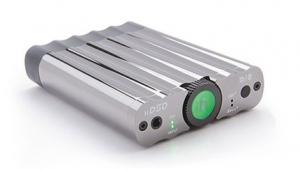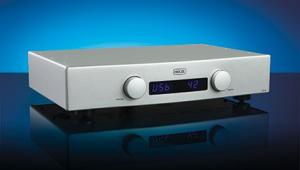Deltec PDM3- £2,650

Back in the late eighties the idea of a separate digital-to-analogue convertor was a very new thing. Until then, the relatively young CD player market had, on the whole, been dominated by larger companies.
Deltec Precision Audio (or DPA) was formed by Robert Watts and Adrian Walker to produce technologically advanced audio components, among which were pre and power amplifi ers as well as one of the first standalone DACs to hit the market, the DPA PDM1. This used surface-mount devices (SMD) in its circuit boards, had one of the first bitstream chipsets and came in a shiny dark grey case. In fact, it looked pretty much like this latest incarnation, the PDM3.
Rock around the linkThe key feature that the PDM3 brings from its predecessors is a clock link. Deltec established rather earlier than most, that the problem with external DACs was that sending a digital signal down a cable into another device introduced jitter. Its engineers figured that if you could introduce a clock link between transport and convertor, then jitter would be minimised. This resulted in the Deltran clock link, which is incorporated into the DAC via a TOSLINK connection and is naturally required in the partnering transport. Deltec modifies players to include this feature and supplied a Cambridge Azur 650C in just such a form for the purpose of the review.
The Deltran device in the DAC sends a master clock reference to the player, in order to produce a low-jitter S/PDIF signal, which can be sent to the DAC by the usual optical or coax methods. Deltec’s claim is that even modest CD players, such as the aforementioned Cambridge, can be turned into a high-quality transport when a Deltran clocking system is fitted.
The casework on this DAC seems to be largely unchanged from its first incarnation, this is because it’s designed to be exceptionally stiff and thus resistant to vibration, presumably at frequencies that will upset the electronics (nothing can stop vibration across the board). The curved front panel is machined from billet aluminium and finished in a deep-powder coat.
The front panel has only a single LED to tell you that it’s on, all the input switching is automatic and based on a priority selection process, although the lack of documentation means that it’s not clear who gets pole position.
There is no option to turn upsampling on or off, because this is that rare thing: a non-upsampling convertor and Deltec considers this near-universal feature to be a corrupting influence. The back panel is naturally a bit more busy, with high-quality RCA phono output sockets beside digital inputs in TOSLINK, electrical coaxial and USB varieties. There is also the Deltran output, which has an on/off toggle switch.
Irritating buzzWe had a little difficulty with our first sample of this convertor, which produced a static-like noise when it was used without Deltran engaged. A second sample cured this, but suffered from higher than usual transformer buzz, a third sample reduced this, but didn’t completely eliminate it. Deltec tells us that there has been a quality issue with this part, which it is addressing and as it was not audible from the listening seat we were able to proceed.
The circuitry inside is designed by Dave Clarke, who incorporated an AK4397 32-bit DAC chip, which is able to accept inputs up to 192kHz (if you can find a source of them with an S/PDIF output). The USB receiver is an iso-synchronous type that only accepts signals up to 48kHz.
Our sample came with Deltec’s Perfect Wave digital interconnects for signal and clocklink, as well as a proprietary mains cable in a rather more substantial gauge than usual. Deltec supplies one Perfect Wave interconnect with every DAC.
On paper, the PDM3 does not look overly competitive, there are plenty of convertors around with USB inputs for less money and some even have volume controls and multiple inputs – Antelope and Benchmark come to mind and both are extremely good-sounding devices for the money. Deltec is also up against the Naim DAC, with its full iPod compatibility and established sonic advantages.
Time loves a heroUsing the S/PDIF output of the Deltran-modified Cambridge 650C as the source, the PDM3 produces a refined, high-resolution sound with good imaging. It’s not the most onthe- ball when it comes to timing however, and this (along with limited dynamic abilities) tends to make music less engaging than it should be. Switching the Deltran link-in does not, in our experience, make a significant difference – which is a bit of a surprise given that this is one of the product’s key USPs.
It is nonetheless a revealing DAC that opens up the layers in a recording to let you hear the quietest sounds, a skill that means you get plenty of texture out of acoustic sounds and no shortage of nuance, especially from voices. Out of interest, we compared it to the signifi cantly more affordable Rega DAC (£498) that we reviewed in HFC 346), this revealed the Deltec’s shortcomings in the timing department rather obviously. It’s the area where the Rega is at its strongest, of course, and in other respects the bigger DAC is considerably more refined and revealing. It sounds more definite, but is not as musically engaging.
Highs are very clean, however, allowing your ear/brain to create convincing stereo solidity. In fact, there is plenty of depth on good recordings and plenty of bass energy to provide scale. The low end is likewise very clean and has a strength to it that gives kick drums genuine kick – a quality we noted being even greater when the Deltec coax lead was used (as opposed to a Chord Signature which sounds more relaxed).
The USB input initially created the static that we’d encountered earlier on, but turning off the Deltran does help (naturally there is no such link upgrade option for computers). This does give our digital files a similar degree of precision and focus, as it does with more traditional sources.
ResistibleThe Deltec fi nds itself in rather more competitive waters than its forebears, especially in a world where products at this price point need to be very strong in all departments to warrant recommendation. And while it is very good at the fine details, it doesn’t have the timing skills, nor the dynamics to make the result irresistible and that’s what we expect for this sort of money. With products like the Electrocompaniet PD-1 (HFC 350) blowing our socks off for less than half the price of the Deltec, makes it rather difficult to recommend.
LIKE: Transparent and revealing convertor
DISLIKE: Timing is not good enough for the money, which undermines musicality
WE SAY: It does not live up to its price and there is some very strong competition in this sector
PRODUCT:
Deltec Precision
Audio PDM3
ORIGIN:
UK
TYPE:
DAC
WEIGHT:
2.6kg
DIMENSIONS:
(WXHXD)
230x100x330mm
FEATURES:
• Digital inputs:
coaxial, TOSLINK
optical, USB B
• Analogue outputs:
RCA phono
• Deltran clock link
• 32-bit DAC
• High-quality
mains lead
DISTRIBUTOR:
Deltec Precision
Audio
TELEPHONE:
01793 238085
WEBSITE:
deltecprecisionaudio. com
 |
Inside this month's issue:
Q Acoustics 3020c standmount loudspeakers, Perlisten R10s active subwoofer, Quad 33 and 303 pre/power amps, Acoustic Solid Vintage Full Exclusive turntable, newcomer Fell Audio Fell Amp and Fell Disc and lots, lots more...
|




















































